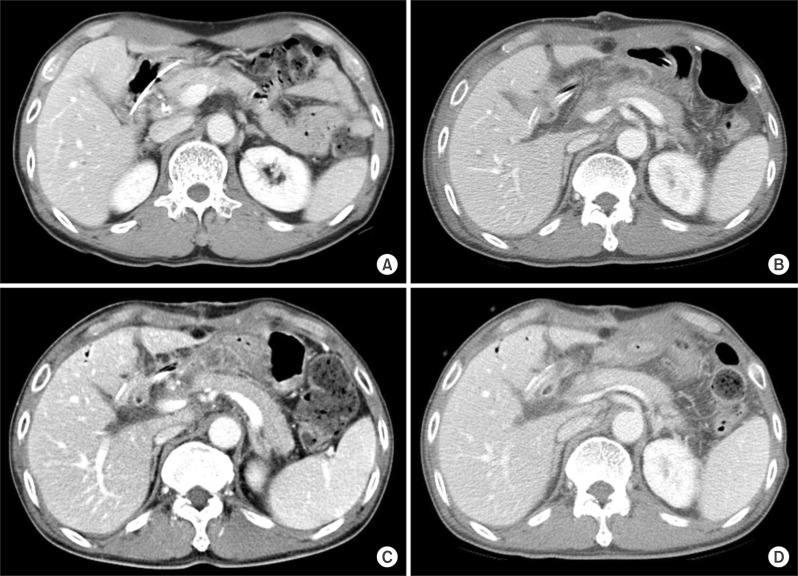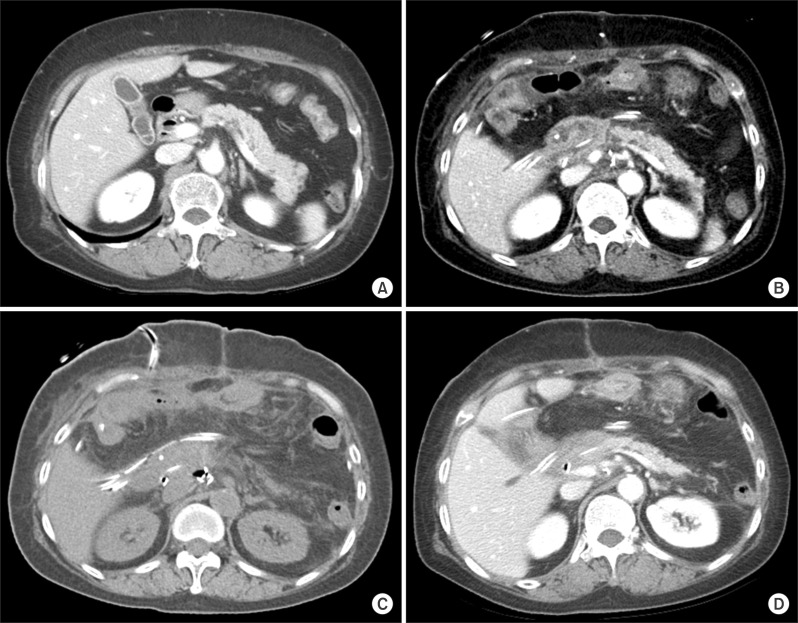Korean J Hepatobiliary Pancreat Surg.
2015 Feb;19(1):17-24. 10.14701/kjhbps.2015.19.1.17.
Therapeutic effect of trans-drain administration of antibiotics in patients showing intractable pancreatic leak-associated pus drainage after pancreaticoduodenectomy
- Affiliations
-
- 1Department of Surgery, Asan Medical Center, University of Ulsan College of Medicine, Seoul, Korea. shwang@amc.seoul.kr
- KMID: 1802235
- DOI: http://doi.org/10.14701/kjhbps.2015.19.1.17
Abstract
- BACKGROUNDS/AIMS
To cope with intractable pus drainage from persistent pancreatic leak after pancreaticoduodenectomy (PD), we have empirically performed local administration of high-concentration antibiotics cocktail solution into abdominal drains. The purpose of this study was to assess its therapeutic effect in patients showing intractable pus drainage after PD.
METHODS
The study group was 10 patients who underwent trans-drain administration of high-concentration antibiotics cocktail solution. Another 10 patients were selected through propensity score matching for the control group. Their medical records were retrospectively reviewed with focus on comparison of pancreatic fistula (PF)-associated clinical sequences.
RESULTS
Postoperative PF of grade B and C occurred in 7 and 3 patients in the study group and 9 and 1 patient in the control group, respectively (p=0.58). In the study group, a mean of 1.8 sessions of antibiotics cocktail solution (imipenem 500 mg and vancomycin 500 mg dissolved in 20 ml of normal saline) was administered. Two patients showed procedure-associated febrile episodes that were spontaneously controlled within 48 hours. At 2-4 days after the first-session of antibiotics administration, pus-like drain discharge turned to be serous with significantly decreased amount. The study group showed shortened postoperative hospital stay comparing to the control group (25.2+/-4.6 vs. 31.8+/-5.6 days, p=0.011). In both groups, no patient received radiological or surgical intervention due to PF-associated complications.
CONCLUSIONS
The results of our study demonstrated that trans-drain administration of antibiotics could be an effective therapeutic option for pancreaticojejunostomy leak-associated infection. Further validation of our result is necessary in large patient populations from multiple centers.
Keyword
MeSH Terms
Figure
Cited by 1 articles
-
Necrosectomy of hepatic left lateral section after blunt abdominal trauma in a patient who underwent central hepatectomy and bile duct resection for perihilar cholangiocarcinoma
Seul Gi Oh, Shin Hwang, Suhyeon Ha, Heewon Kim, Lee Na Ryu
Ann Hepatobiliary Pancreat Surg. 2020;24(3):345-351. doi: 10.14701/ahbps.2020.24.3.345.
Reference
-
1. Trede M, Schwall G. The complications of pancreatectomy. Ann Surg. 1988; 207:39–47. PMID: 3276272.
Article2. Miedema BW, Sarr MG, van Heerden JA, Nagorney DM, McIlrath DC, Ilstrup D. Complications following pancreaticoduodenectomy. Current management. Arch Surg. 1992; 127:945–949. PMID: 1353671.3. Yeo CJ. Management of complications following pancreaticoduodenectomy. Surg Clin North Am. 1995; 75:913–924. PMID: 7660254.4. Aranha GV, Aaron JM, Shoup M, Pickleman J. Current management of pancreatic fistula after pancreaticoduodenectomy. Surgery. 2006; 140:561–568. PMID: 17011903.
Article5. Goldsmith HS, Ghosh BC, Huvos AG. Ligation versus implantation of the pancreatic duct after pancreaticoduodenectomy. Surg Gynecol Obstet. 1971; 132:87–92. PMID: 5538818.6. Di Carlo V, Chiesa R, Pontiroli AE, Carlucci M, Staudacher C, Zerbi A, et al. Pancreatoduodenectomy with occlusion of the residual stump by Neoprene injection. World J Surg. 1989; 13:105–110. PMID: 2543144.
Article7. Suc B, Msika S, Fingerhut A, Fourtanier G, Hay JM, Holmières F, et al. French Associations for Surgical Research. Temporary fibrin glue occlusion of the main pancreatic duct in the prevention of intra-abdominal complications after pancreatic resection: prospective randomized trial. Ann Surg. 2003; 237:57–65. PMID: 12496531.8. Lillemoe KD, Cameron JL, Kim MP, Campbell KA, Sauter PK, Coleman JA, et al. Does fibrin glue sealant decrease the rate of pancreatic fistula after pancreaticoduodenectomy? Results of a prospective randomized trial. J Gastrointest Surg. 2004; 8:766–772. PMID: 15531229.
Article9. Büchler M, Friess H, Klempa I, Hermanek P, Sulkowski U, Becker H, et al. Role of octreotide in the prevention of postoperative complications following pancreatic resection. Am J Surg. 1992; 163:125–130. PMID: 1733360.
Article10. Pederzoli P, Bassi C, Falconi M, Camboni MG. Efficacy of octreotide in the prevention of complications of elective pancreatic surgery. Italian Study Group. Br J Surg. 1994; 81:265–269. PMID: 8156354.11. Strasberg SM, Drebin JA, Mokadam NA, Green DW, Jones KL, Ehlers JP, et al. Prospective trial of a blood supply-based technique of pancreaticojejunostomy: effect on anastomotic failure in the Whipple procedure. J Am Coll Surg. 2002; 194:746–758. PMID: 12081065.12. Aranha GV, Hodul P, Golts E, Oh D, Pickleman J, Creech S. A comparison of pancreaticogastrostomy and pancreaticojejunostomy following pancreaticoduodenectomy. J Gastrointest Surg. 2003; 7:672–682. PMID: 12850681.
Article13. Hwang S, Ha TY, Kim JS, Cheong O, Kim KH, Lee SG. Clinical application of sution-type cigarette drain for hepatopancreatoabiliary surgery. J Korean Surg Soc. 2004; 67:428–431.14. Bassi C, Falconi M, Molinari E, Mantovani W, Butturini G, Gumbs AA, et al. Duct-to-mucosa versus end-to-side pancreaticojejunostomy reconstruction after pancreaticoduodenectomy: results of a prospective randomized trial. Surgery. 2003; 134:766–771. PMID: 14639354.
Article15. Bassi C, Dervenis C, Butturini G, Fingerhut A, Yeo C, Izbicki J, et al. Postoperative pancreatic fistula: an international study group (ISGPF) definition. Surgery. 2005; 138:8–13. PMID: 16003309.
Article16. Facy O, Chalumeau C, Poussier M, Binquet C, Rat P, Ortega-Deballon P. Diagnosis of postoperative pancreatic fistula. Br J Surg. 2012; 99:1072–1075. PMID: 22539219.
Article17. Jung DH, Hwang S, Lee SG. An analysis on the amount of excreted pancreatic juice after pancreatoduodenectomy. Korean J Gastroenterol. 2004; 43:309–315. PMID: 15156118.18. Yoo D, Hwang S, Kim KH, Ahn CS, Moon DB, Ha TY, et al. Pancreatic atrophy relative to external versus internal drainage of the pancreatic duct after pylorus-preserving pancreaticoduodenectomy. J Gastrointest Surg. 2014; 18:1604–1609. PMID: 25002021.
Article19. El Nakeeb A, Salah T, Sultan A, El Hemaly M, Askr W, Ezzat H, et al. Pancreatic anastomotic leakage after pancreaticoduodenectomy. Risk factors, clinical predictors, and management (single center experience). World J Surg. 2013; 37:1405–1418. PMID: 23494109.
Article20. Strasberg SM, Drebin JA, Soper NJ. Evolution and current status of the Whipple procedure: an update for gastroenterologists. Gastroenterology. 1997; 113:983–994. PMID: 9287993.
Article21. Kim JH, Yoo BM, Kim JH, Kim WH. Which method should we select for pancreatic anastomosis after pancreaticoduodenectomy? World J Surg. 2009; 33:326–332. PMID: 19057947.
Article
- Full Text Links
- Actions
-
Cited
- CITED
-
- Close
- Share
- Similar articles
-
- The Role of External Drainage and Octreotide in Preventing Complications after Pancreaticoduodenectomy
- Effect of Synthetic Somatostatin on Exocrine Pancreatic Function after Pancreatic Head Resection
- The impact of perioperative inotropes on the incidence of pancreatic leak following pancreaticoduodenectomy
- Effectiveness of external drainage of the bile duct in pancreaticoduodenectomy: a single surgeon's experience
- Endoscopic Drainage of Pseudocysts



